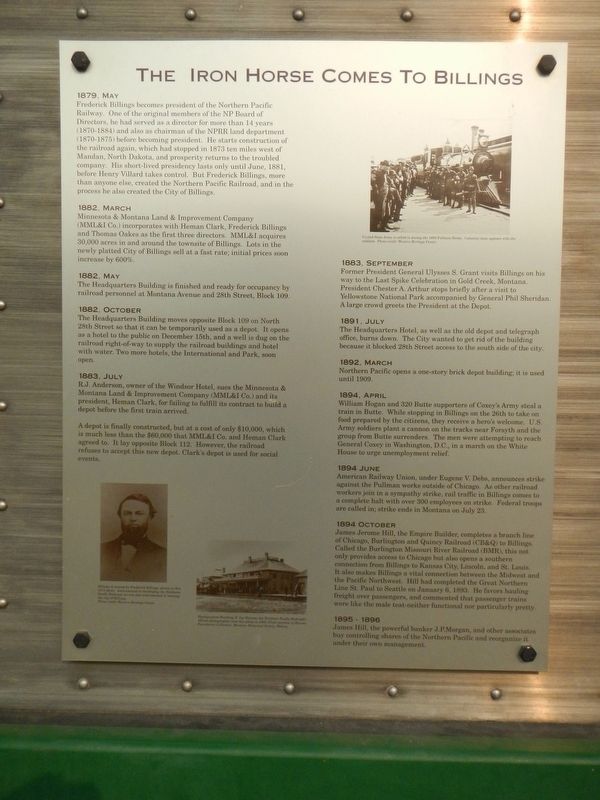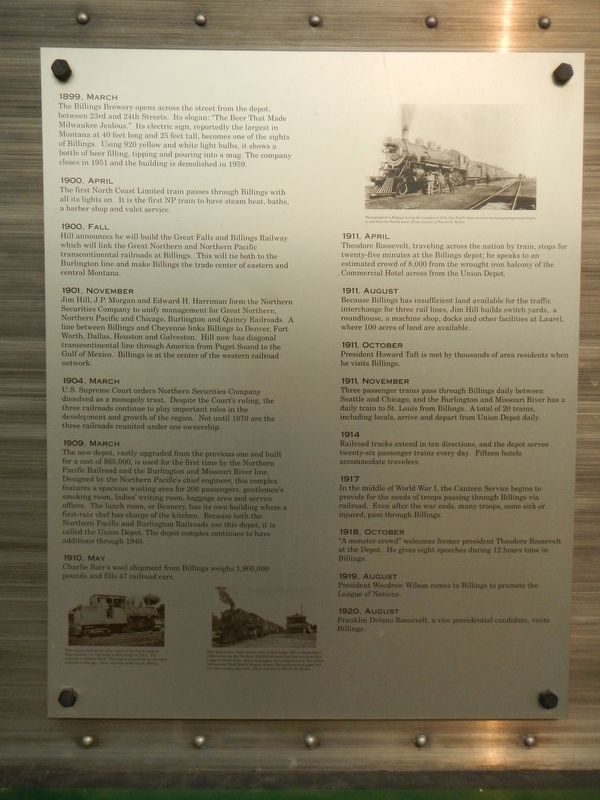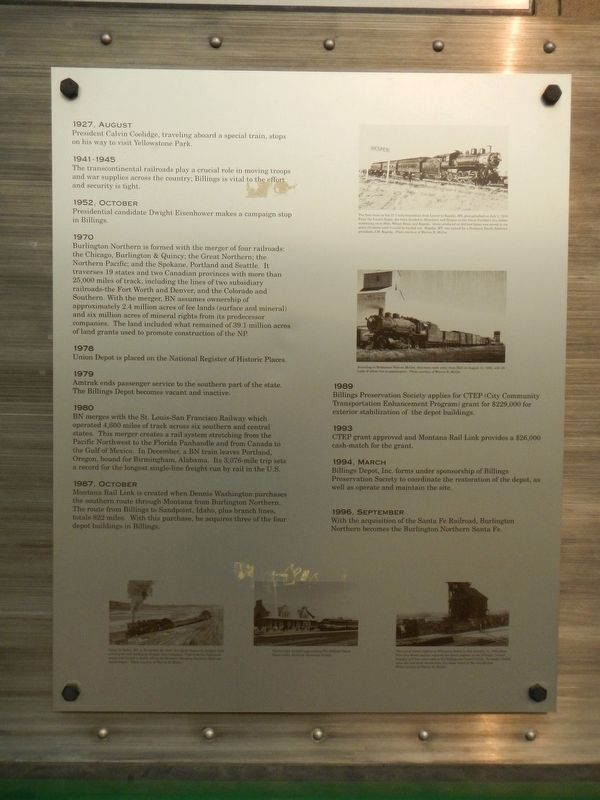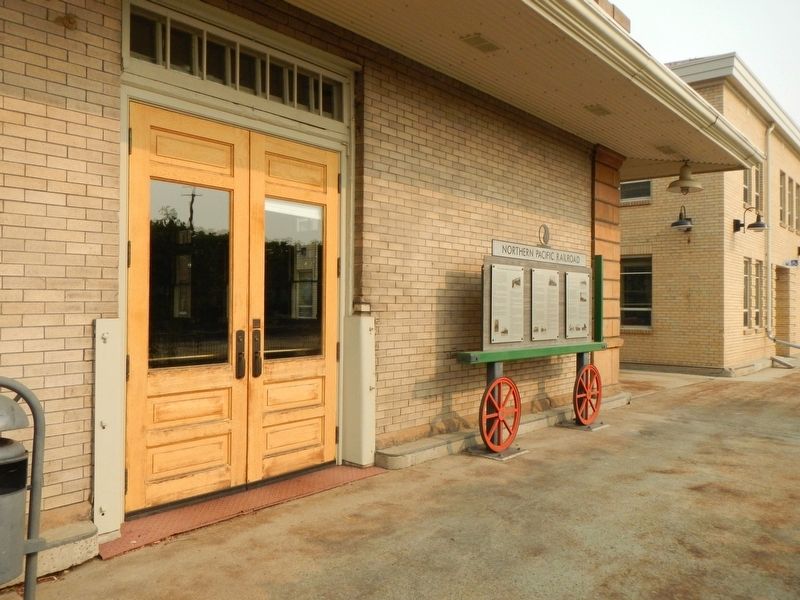South Side in Billings in Yellowstone County, Montana — The American West (Mountains)
The Iron Horse Comes To Billings

Photographed By Barry Swackhamer, September 15, 2020
1. The Iron Horse Comes To Billings Marker, panel 1
Captions: (bottom left) Billings is named for Frederick Billings, shown in this 1874 photo. Instrumental to developing the Northern Pacific Railroad, he was also instrumental in locating the city of Billings.; Headquarters Building. F. Jay Haynes, the Northern Pacific Railroad's official photographer, took this photo in 1883.; (upper right) United State (sic) Army is called in during the 1894 Pullman Strike. Calamity Jane appears with the soldiers.
(The marker is composed of three panels.)
(Panel 1:)
1879, May
Frederick Billings becomes president of the Northern Pacific Railway. One of the original members of the NP Board of Directors, he had served as director for more than 14 years (1870-1884) and also as chairman of the NPRR land department (1870-1875) before becoming president. He starts construction of the railroad again, which had stopped in 1973 ten miles west of Mandan, North Dakota, and prosperity returns to the troubled company. His short-lived presidency lasts only until June, 1881, before Henry Villard takes control. But Frederick Billings, more than anyone else, created the Northern Pacific Railroad, and in the process he also created the City of Billings.
1882, March
Minnesota & Montana Land & Improvement Company (MML&I Co.) incorporates with Heman Clark, Frederick Billings and Thomas Oakes as the first three directors. MML&I acquires 30,000 acres in and around the townsite of Billings. Lots in the newly platted City of Billings sell at a fast rate; initial prices soon increase by 600%.
1882, May
The Headquarters Building is finished and ready for occupancy by railroad personnel at Montana Avenue and 28th Street, Block 109.
1882, October
The Headquarters Building moves opposite Block 109 on North 28th Street so that it can be temporarily used as a depot. It opens as a hotel to the public on December 15th, and a well is dug on the railroad right-of-way to supply the railroad building and hotel with water. Two more hotels, the International and Park, soon open.
1883, July
R.J. Anderson, owner of the Windsor Hotel, sues the Minnesota & Montana Land & Improvement Company (MML&I Co.) and its president, Heman Clark, for failing to fulfill its contract to build a depot before the first train arrived. A depot is finally constructed, but at a cost of only $10,000, which is much less than the $60,000 that MML&I Co. and Heman Clark agreed to. It lay opposite Block 112. However, the railroad refuses to accept this new depot. Clark's depot is used for social events.
1883, September
Former President General Ulysses S. Grant visits Billings on his way to the Last Spike Celebration in Gold Creek, Montana. President Chester A. Arthur stops briefly after a visit to Yellowstone National Park accompanied by General Phil Sheridan. A large crowd greets the President at the Depot.
1891, July
The Headquarters Hotel, as well as the old depot and telegraph office, burns down. The City wanted to get rid of the building because it blocked 28th Street access to the south

Photographed By Barry Swackhamer, September 15, 2020
2. The Iron Horse Comes To Billings Marker, panel 2
Captions: (bottom left) This engine worked the mine-tipple of the Northwestern Improvements Co. coal mine in Red Lodge in 1915. The engineer is Palmer Boyd. The engine came from the elevated railroad in Chicago.; This Yellowstone Park tourist train in Red Lodge, MT on September 1, 1939 is met by the Northern Pacific transport bus that ran from Red Lodge to Silver Gate, where passengers were transferred to the yellow Yellowstone Park Hotel Company buses. The mailman and paper boy are also meeting the train.; (upper right) Photographed in Billings during the summer of 1915, this Pacific Express train carried passengers and freight to and from the Pacific coast.
1892, March
Northern Pacific opens a one-story brick depot building; it is used until 1909.
1894, April
William Hogan and 320 Butte supporters of Coxey's Army steal a train if Butte. While stopping in Billings on the 26th to take on food prepared by the citizens, they receive a hero's welcome. U.S. Army soldiers plant a cannon on the tracks near Forsyth and the group from Butte surrenders. The men were attempting to reach General Coxey in Washington, D.C., in a march on the White House to urge unemployment relief.
1894, June
American Railway Union, under Eugene V. Debs, announces strike against the Pullman works outside of Chicago. As other railroad workers join in a sympathy strike, rail traffic in Billings comes to a complete halt with over 300 employees on strike. Federal troops are called in; strike ends in Montana on July 23.
1894, October
James Jerome Hill, the Empire Builder, completed a branch line of Chicago, Burlington and Quincy Railroad (CB&Q) to Billings. Called the Burlington Missouri River Railroad (BMR), this not only provides access to Chicago but also opens a southern connection from Billings to Kansas City, Lincoln, and St. Louis. It also makes Billings a vital connection between the Midwest and the Pacific Northwest. Hill had completed the

Photographed By Barry Swackhamer, September 15, 2020
3. The Iron Horse Comes To Billings Marker, panel 3
Captions: (bottom left) Taken at Belfry, MT on November 26, 1940, this photo shoes the Bridger local arriving for coal loading by Brophy Coal Company. Coal from the Bearcreek mines was hauled to Belfry where the Montana Wyoming Southern Railroad tracks began.; (bottom center) North Coast Limited approaching the Billings Depot. (bottom right) The end of steam engines at Billings is shown in this January 12, 1964 photo. New Alco diesel engines replaced the steam engines on the Billings, Laurel transfer and four were used in the Billings and Laurel yards. No longer needed were the coal dock shown here, the water tower or the roundhouse.; (top right) The first train on the 37.7 mile branchline from Laurel to Rapelie, MT photographed on July 1, 1918. From there Laurel Depot, the train headed to Mossmain and Hesper on the Great Northern line before continuing on to Molt, Wheat Basin and Rapelie. Grain produced on drylands farms was stored in six grain elevators until it could be hauled out. Rapelie, MT was named for a Northern Pacific Railroad president, J.M. Rapelie.; (middle right) According to Brakeman Warren McGee, this train came away from Molt on August 11, 1938 with 25 loads of wheat but no passengers.
1895-1896
James Hill, the powerful banker J.P. Morgan, and other associated by controlling shares of the Northern Pacific and reorganize it under their own management.
(Panel 2:)
1899, March
The Billings Brewery opens across the street from the depot, between 23rd and 24th Streets. Its slogan: "The Beer That Made Milwaukee Jealous." Its electric sign, reportedly the largest in Montana at 40 feet long and 25 feet tall, becomes one of the sights of Billings. Using 920 yellow and white light bulbs, it shows a bottle of beer filling, tipping and pouring into a mug. The company closed in 1951 and the building is demolished in 1959.
1900, April
The first North Coast Limited train passes through Billings with all its lights on. It is the first NP train Mohave steam heat, baths, a barber shop and valet service.
1900, Fall
Hill announces he will build the Great Falls and Billings Railway which will link the Great Northern and Northern Pacific transcontinental railroads at Billings. This will tie both to the Burlington line and make Billings the trade center of eastern and central Montana.
1901, November
Jim Hill, J.P. Morgan and Edward H. Harriman form the Northern Securities Company to unify management for Great Northern, Northern Pacific and Chicago, Burlington and Quincy Railroads. A line between Billings and Cheyenne links Billings to Denver, Fort Worth, Dallas, Houston and Galveston. Hill now has diagonal transcontinental line through America from Puget Sound to Gulf of Mexico. Billings is at the center of the western railroad network.
1904, March
U.S. Supreme Court orders Northern Securities Company dissolved as a monopoly trust. Despite the Court's ruling, the three railroads continue to play important roles in the development and growth of the region. Not until 1970 are the three railroads reunited under one ownership.
1909, March
The new depot, vastly upgraded from the previous one and built for a cost of $65.000, is used for the first time by the Northern Pacific Railroad and the Burlington and Missouri River line. Designed by the Northern Pacific's chief engineer, this complex features a spacious waiting area for 200 passengers, gentlemen's smoking room, ladies' writing room, baggage area and service offices. The lunch room, or Beanery, has its own building where a first-rate chef has charge of the kitchen. Because both the Northern Pacific and Burlington Railroads use this depot, it is called the Union Depot. The depot complex continues to have additions through 1940.
1910, May
Charlie Blair's wool shipment from Billings weights 1,900,000 pounds and fills 47 railroad cars.
1911, April
Theodore Roosevelt, traveling across the nation by train, stops for twenty-five minutes at Billings depot; he speaks to an estimated crowd of 8,000 from the wrought iron balcony of he Commercial Hotel across from the Union Depot.
1911, August
Because Billings has insufficient land available for the traffic interchange for three rail lines, Jim Hill builds switch yards, a roundhouse, a machine shop, docks and other facilities at Laure, where 100 acres of land are available.
1911, October
President Howard Taft is met by thousands of area residents when he visits Billings.
1911, November
Three passenger trains pass through Billings daily between Seattle and Chicago, and the Burlington and Missouri River has a daily train to St. Louis from Billings. A total of 20 trains, including locals, arrive and depart from Union Depot daily.
1914
Railroad tracks extend in ten directions, and the depot serves twenty-six passenger trains every day. Fifteen hotels accommodate travelers.
1917
In the middle of World War I, the Canteen Service begins to provide for the needs of troops passing through Billings via railroad. Even after the war ends, many troops, some sick or injured, pass through Billings.
1918, October
"A monster crowd" welcomes former president Theodore Roosevelt at the Depot. He gives eight speeches during 12 hours time in Billings.
1919, August
President Woodrow Wilson come to Billings to promote the League os Nations.
1920, August
Franklin Delano Roosevelt, a vice-presidential candidate, visits Billings.
(Panel 3:)
1927, August
President Calvin Coolidge, traveling aboard a special train, stops on his way to visit Yellowstone Park.
1941-1945
The transcontinental railroads play a crucial role in moving troops and war supplies across the country; Billings is vital to the effort and security is tight.
1952, October
Presidential candidate Dwight Eisenhower makes a campaign stop in Billings.
1970
Burlington Northern is formed with the merger of four railroads; the Chicago, Burlington & Quincy; the Great Northern: the Northern Pacific; and the Spokane, Portland and Seattle. It traverses 19 states and two Canadian provinces with more than 25,000 miles of track, including the lines two subsidiary railroads-the Fort Worth and Denver, and the Colorado and Southern. With the merger, BN assumes ownership of approximately 2.4 million acres of fee lands (surface and mineral) and six million acres of mineral rights from its predecessor companies. The land includes what remains of 39.1 million acres of land grants used to promote construction of the NP.
1978
Union Depot is placed on the National Register of Historic Places.
1979
Amtrak ends passenger service to the southern part of the state. The Billings Depot becomes vacant and inactive.
1980
BN merges with the St. Louis-San Francisco Railway which operated 4,600 miles of track across six southern and central states. This merger creates a rail system stretching from the Pacific Northwest to the Florida Panhandle and from Canada to the Gulf of Mexico. In December, a BN train leaves Portland, Oregon bound for Birmingham, Alabama. Its 3,076-mile trip sets a record for the longest single-line freight run by rail in the U.S.
1987, October
Montana Rai Link is created when Dennis Washington purchases the southern route through Montana from Burlington Northern. The route from Billings to Sandpoint, Idaho, plus branch lines, totals 822 miles. With this purchase, he acquires three of the four depot buildings in Billings.
1989
Billings Preservation Society applies for CTEP (City Community Transportation Enhancement Program) grant for $229,000 for exterior stabilization of the depot buildings.
1993
CTEP grant approval and Montana Rail Link provides a $26,000 cash-match for the grant.
1994, March
Billings Depot, Inc. forms under sponsorship of Billings Preservation Society to coordinate the restoration of the depot, as well as operate and maintain the site.
1996, September
With the acquisition of the Santa Fe Railroad, Burlington Northern becomes the Burlington Northern Santa Fe.
Topics. This historical marker is listed in this topic list: Railroads & Streetcars.
Location. 45° 47.038′ N, 108° 29.923′ W. Marker is in Billings, Montana, in Yellowstone County. It is in the South Side. Marker can be reached from Montana Avenue (Business Interstate 90) near North 23rd Street, on the right when traveling east. The marker is locate at the rear, trackside, of the Union Depot. Touch for map. Marker is at or near this postal address: 2310 Montana Avenue, Billings MT 59101, United States of America. Touch for directions.
Other nearby markers. At least 8 other markers are within walking distance of this marker. The People's Mansion (here, next to this marker); St. Vincent Healthcare (a few steps from this marker); Parks for the People (a few steps from this marker); Black Gold (a few steps from this marker); All We Need is Some Water (within shouting distance of this marker); Houses of Ill Repute (within shouting distance of this marker); The Yellowstone Garage - 1920 (within shouting distance of this marker); Teddy Roosevelt Visits the Depot - 1918 (within shouting distance of this marker). Touch for a list and map of all markers in Billings.
Credits. This page was last revised on February 16, 2023. It was originally submitted on March 13, 2021, by Barry Swackhamer of Brentwood, California. This page has been viewed 297 times since then and 35 times this year. Photos: 1, 2, 3, 4. submitted on March 13, 2021, by Barry Swackhamer of Brentwood, California.
